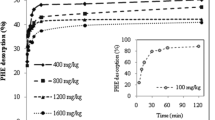Abstract
This paper analyzes the mathematical modeling procedure to describe the decomposition of adsorbed phenanthrene in prototypical and real soil samples (sand and agricultural soil, respectively) by ozone. The modeling scheme considered a set of ordinary differential equations with time varying coefficients. This model used the adsorbed ozone in the soil, the ozone reacting with the contaminant and the phenanthrene concentration in the soil sample. The main parameters involved in the mathematical model included a time varying ozone saturation function (k sat (t)) and reaction constants (k r). These parameters were calculated using the ozone concentration variation at the reactor output, named as ozonogram, and the measurements of phenanthrene decomposition through ozonation. The model was validated using two series of experiments: (1) soil saturated with ozone in the absence of the contaminant and (2) soil artificially contaminated with phenanthrene. In both cases, the proposed parametric identification method yields to validate the mathematical model. This fact was confirmed by the correspondence between numerical simulations and experimental data. In particular, total decomposition of phenanthrene adsorbed in two different systems (ozone-sand and ozone-agricultural soil) was obtained after 15 and 30 min of reaction, respectively. This difference was obtained as a consequence of soil physicochemical characteristics: specific surface area and pore volume. The ozonation reaction rate constants of phenanthrene in the sand and agricultural soil were calculated using the same parameter identification scheme.






Similar content being viewed by others
References
Bin, A.K., Roustand, M. (2002). Mass transfer in ozone reactors. Proceeding of the international specialized symposium of IOA/EA3G. Fundamental and Engineering Concepts of Ozone Reactor Design. France 99–131.
Chiang, P. C., Chang, E. E., & Liang, C. H. (2002). NOM characteristics and treatability of ozonation processes. Chemosphere, 46, 929–936.
Derudi, M., Venturini, G., Lombardi, G., Nano, G., & Rota, R. (2007). Biodegradation combined with ozone for the remediation of contaminated soils. European Journal of Soil Biology, 43, 297–303.
Dong, W., Wang, W., & Lia, J. (2008a). A multiscale mass transfer model for gas–solid riser flows: part II—sub-grid simulation of ozone decomposition. Chemical Engineering Science, 63, 2811–2823.
Dong, W., Wang, W., & Lia, J. A. (2008b). Multiscale mass transfer model for gas–solid riser flows: part I sub-grid model and simple tests. Chemical Engineering Science, 63, 2798–2810.
Haapea, P., & Tuhkanen, T. (2006). Integrated treatment of PAH contaminated soil by soil washing. Ozonation and biological treatment. Journal of Hazardous Materials, B136, 244–250.
Heechul, C. (2002). Transport characteristics of gas phase ozone in unsaturated porous media for in-situ chemical oxidation. Journal of Contaminant Hydrology, 57, 81–98.
Kahan, T. F., Kwamena, N. O. A., & Donaldson, D. J. (2006). Heterogeneous ozonation kinetics of polycyclic aromatic hydrocarbons on organic films. Atmospheric Environment, 40, 3448–3459.
Kim, J., & Heechul, C. (2002). Modeling in situ ozonation for the remediation of nonvolatile PAH-contaminated unsaturated soils. Journal of Contaminant Hydrology, 55, 261–285.
Kulik, N., Goi, A., Trapido, M., & Tunkanen, T. (2006). Degradation of polycyclic aromatic hydrocarbons by combined chemical pre-oxidation and bioremediation in creosote contaminated soil. Journal of Enviromental Management, 78, 382–321.
Lee, B. T., & Kim, K. W. (2002). Ozonation of diesel fuel in unsaturated porous media. Applied Geochemistry, 17(8), 1165–1170.
Lima, H. N., Choi, H., Hwang, T. M., & Kang, J. W. (2002). Characterization of ozone decomposition in soil slurry: kinetics and mechanism. Water Research, 36, 219–229.
Luster-Teasley, S., Ubaka-Blackmoor, N., & Masten, S. J. (2010). Evaluation of soil pH and moisture content on in-situ ozonation of pyrene in soils. Journal of Hazardous Materials, 167, 701–706.
McKeague, J. A. (1976). Manual on Soil Sampling and Methods of Analysis. Prepared by Subcommittee on Methods of Analysis of Canadian Soil Survey Committee. Ottawa, Ontario. (ed.)
O’Mahony, M., Dobson, A., Barnes, J., & Singleton, I. (2005). The use of ozone in the remediation of polycyclic aromatic hydrocarbon contaminated soil. Chemosphere, 63, 307–314.
Perraudina, E., Budzinskia, H., & Villenaveb, E. (2006). Identification and quantification of ozonation products of anthracene and phenanthrene adsorbed on silica particles. Atmospheric Environment, 41, 6005–6017.
Pierpoint, C. A., Hapeman, C. J., & Torrents, A. (2003). Ozone treatment of soil contaminated with aniline and trifluralin. Chemosphere, 50, 1025–1034.
Poznyak, T., Chairez, I., & Poznyak, A. (2005). Application of a neural observer phenols ozonation in water: simulation and kinetic parameters identification. Water Research, 39, 2611–2620.
Poznyak, T., Manzo, A., Mayorga. J. L. (2006). Elimination of chlorinated unsaturated hydrocarbons from water by Ozonation. Simulation and experimental data comparison. Revista de la Sociedad Química de México. 58–65.
Poznyak, T., García, A., Chairez, I., Gómez, M., & Poznyak, A. (2007). Application of the differential neural network observer to the kinetic parameters identification of the anthracene degradation in contaminated model soil. Journal of Hazardous Material, 146, 661–667.
Rivas, F. (2006). Polycyclic aromatic hydrocarbons sorbed on soils: a short review of chemical oxidation based treatments. Journal of Hazardous Materials, B138, 264–251.
Rivas, F. J., García de la Calle, R., Álvarez, P., & Acedo, B. (2008). Polycyclic aromatic hydrocarbons sorption on soils: some anomalous isotherms. Journal of Hazardous Materials, 58, 375–383.
Shin, W. T. (2004). Kinetics of soil ozonation: experimental and numerical investigation. Journal of Contaminant Hydrology, 72, 227–243.
Takayama, M., Ebihara, K., Stryczewska, H., Ikegami, T., Gyoutoku, Y., Kubo, K., & Tachibana, M. (2006). Ozone generation by dielectric barrier discharge for soil sterilization. Thin Solid Films, 506, 396–399.
Yu, D. Y., Kang, N., Bae, W., & Banks, M. K. (2007). Characteristics in oxidative degradation by ozone for saturated hydrocarbons in soil contaminated with diesel fuel. Chemosphere, 66, 799–807.
Acknowledgments
The authors thank the Department of Graduate Study and Investigation of the National Polytechnic Institute of Mexico (Project No. 20080171) and the National Counsel of Science and Technology of Mexico—CONACyT (Project No. 49367) for the supporting of this investigation.
Author information
Authors and Affiliations
Corresponding author
Rights and permissions
About this article
Cite this article
Rodriguez-Aguilar, J., Garcia-Gonzalez, A., Poznyak, T. et al. Modeling the Phenanthrene Decomposition Adsorbed in Soil by Ozone: Model Characterization and Experimental Validation. Water Air Soil Pollut 226, 200 (2015). https://doi.org/10.1007/s11270-015-2378-6
Received:
Accepted:
Published:
DOI: https://doi.org/10.1007/s11270-015-2378-6




